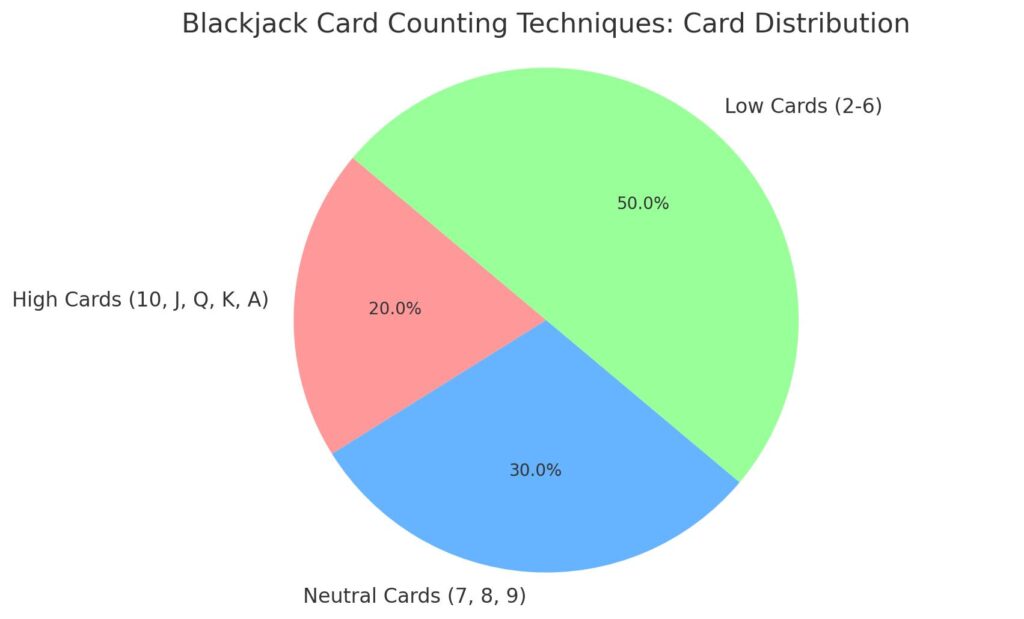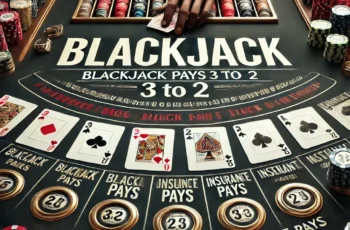Blackjack card counting techniques have intrigued casino enthusiasts and professional gamblers alike for decades. Understanding these techniques is crucial for anyone looking to gain an edge in the game. This blog delves into the nuances of card counting, its effectiveness, and its application in real-world scenarios. Whether you’re a beginner or an experienced player, this guide will provide you with the insights you need to improve your blackjack game.
What are Blackjack Card Counting Techniques?

Blackjack card counting techniques involve tracking the ratio of high to low cards remaining The primary objective is to determine when the player has a statistical advantage over the house. These techniques are based on the premise that high-value cards (10, Jack, Queen, King, Ace) benefit the player more, while low-value cards (2 through 6) benefit the dealer.
Key Components of Card Counting Techniques
- Running Count: This is the core of most card counting systems. Players assign specific values to cards as they are dealt and keep a cumulative total. For example, in the high-low system, cards 2-6 are given a value of +1, 7-9 are neutral (0), and 10-Ace are -1.
- True Count: This is an adjustment of the running count that accounts for the number of decks remaining in the shoe. It provides a more accurate representation of the player’s advantage. To calculate the true count, the running count is divided by the number of remaining decks.
- Betting Strategy: Card counting is not just about tracking cards but also about adjusting bets based on the count. When the true count is high, the player increases bets because the likelihood of getting high-value cards is greater.
- Playing Strategy: Beyond betting, players adjust their decisions (hit, stand, double down, etc.) based on the count. For instance, a player might stand on a lower total if the count is high, anticipating a higher probability of the dealer busting.
Common Card Counting Systems
- High-Low System: One of the most popular and straightforward methods, assigning +1 to low cards (2-6), 0 to medium cards (7-9), and -1 to high cards (10-Ace).
- KO (Knock-Out) System: Similar to the high-low system but does not require a true count adjustment, making it easier for beginners.
- Zen Count: A more complex system that assigns different values (+1, +2, 0, -1, -2) to different cards, aiming for greater accuracy.
- Omega II: An advanced system assigning +1, +2, -1, -2 to cards for more precise tracking, useful for experienced counters.
Practical Application of Card Counting
- Preparation: Before attempting card counting in a live casino, players should practice extensively at home or using online simulators. Familiarity with the system and quick mental calculations are crucial.
- Bankroll Management: Successful card counters must manage their bankroll carefully, adjusting their bet sizes based on the count to maximize winnings and minimize losses.
- Avoiding Detection: Since casinos frown upon card counting, players need to be discreet. This includes varying bet sizes subtly and blending in with other players to avoid drawing attention.
How Effective is Card Counting in Blackjack?
Is card counting effective in blackjack? Yes, card counting is effective, but its effectiveness depends on the player’s skill and the casino’s countermeasures. Advanced blackjack card counting can significantly improve a player’s odds, but it requires practice and precision. The success of card counting also relies on the player’s ability to avoid detection and manage their bankroll effectively.
Can You Still Count Cards in Modern Casinos?
No, counting cards in modern casinos is not as easy as it used to be. Casinos have implemented various countermeasures to detect and prevent card counting. These measures include frequent shuffling of the deck, using multiple decks, and employing surveillance teams. However, with the right techniques and discretion, it is still possible. Successful card counters know how to blend in with other players, use subtle techniques, and leave the table when necessary to avoid detection.
What is the History of Card Counting in Blackjack?
Card counting in blackjack dates back to the 1960s when mathematician Edward Thorp introduced the concept in his book “Beat the Dealer.” This groundbreaking work provided a mathematical basis for card counting, making it accessible to the public. Over the years, various card counting systems have been developed, each with its own level of complexity and effectiveness. The history of card counting is filled with stories of professional card counters who have used these techniques to win significant sums of money, often becoming legends in the gambling world.
Is Card Counting in Blackjack Illegal?
No, card counting in blackjack is not illegal, but casinos reserve the right to refuse service to anyone they suspect of counting cards. While card counting is a legitimate strategy, casinos view it as a threat to their profits. Players should be aware of the legal implications and casino policies when practicing card counting techniques. It’s essential to understand that while card counting itself is not against the law, using devices to aid in counting or colluding with others can lead to legal issues.
What Are the Basic Principles of Card Counting?
The basic principles of card counting involve assigning values to cards and keeping a running count to estimate the ratio of high to low cards remaining in the deck. High cards (10, Jack, Queen, King, Ace) are typically assigned a negative value, while low cards (2-6) are given a positive value. This running count helps players make informed betting decisions and adjust their strategies accordingly. The goal is to:
- Increase bets when the count is favorable
- Decrease bets when it is not
- Maximize profits and minimize losses
How Does the High-Low Card Counting System Work?
The high-low card counting system is one of the most popular and straightforward methods. It involves assigning:
- +1 to cards 2-6
- 0 to cards 7-9
- -1 to 10, Jack, Queen, King, and Ace
By keeping a running count of these values, players can determine the composition of the remaining deck and adjust their bets and strategies to gain an advantage. The simplicity of this system makes it accessible to beginners while still being effective enough for more experienced players.
What is the True Count in Blackjack?
The true count is a refinement of the running count, taking into account the number of decks remaining. To calculate the true count:
- Divide the running count by the estimated number of decks left in the shoe
- This adjustment helps players make more accurate predictions
- Improves the effectiveness of card counting techniques
Can Beginners Learn Card Counting Easily?
Yes, beginners can learn card counting, but it requires dedication and practice. Starting with simpler systems like the high-low method is recommended. Beginners should focus on mastering the basic principles and gradually progress to more advanced techniques. Consistent practice and studying resources like “Professional Blackjack” by Stanford Wong can help beginners become proficient card counters. It’s important for beginners to practice regularly and stay patient, as card counting skills develop over time.
What Are Advanced Card Counting Techniques?
Advanced card counting techniques go beyond the basic high-low system and include methods like the Zen Count, Wong Halves, and Omega II. These systems assign different values to cards and require more complex calculations. While advanced techniques can offer greater accuracy and higher profits, they also demand more practice and skill. Players who master these advanced techniques can gain a significant edge over the casino, but it’s important to weigh the increased complexity against the potential benefits.
How to Practice Card Counting at Home?
Practicing card counting at home involves using a deck of cards to simulate real-game conditions. Steps to practice include:
- Shuffling the deck
- Dealing the cards while keeping a running count
- Using online card counting trainers and apps
- Practicing in a distraction-free environment
- Gradually increasing speed
These methods help you become proficient and confident in your card counting abilities.
Can Card Counting Improve Your Blackjack Game?
Yes, card counting can significantly improve your blackjack game by giving you a mathematical edge over the casino. By using effective card counting strategies, players can make more informed decisions, increase their chances of winning, and manage their bankroll better. However, success also depends on discipline, practice, and the ability to avoid detection. Card counting is not a guaranteed way to win, but it can tilt the odds in your favor when executed correctly.
What Are the Different Card Counting Systems?
There are several card counting systems, each with varying levels of complexity and effectiveness. Some popular systems include:
- The high-low system
- The Zen Count
- Wong Halves
- Hi-Opt I and II
Each system has its pros and cons, and players should choose one that matches their skill level and goals. Understanding the differences between these systems can help players decide which one to use based on their comfort level and desired accuracy.
How to Use Card Counting Software?
Card counting software can be a valuable tool for practice and analysis. Programs like Casino Verite and apps designed for mobile devices allow players to simulate real-game conditions, track their progress, and refine their techniques. Using software helps players understand their strengths and weaknesses, making it easier to improve their card counting skills. These tools often include features like drills, statistical analysis, and tutorials, providing a comprehensive learning experience.
What Are Professional Card Counters’ Strategies?
Professional card counters use a combination of advanced techniques, team play, and discretion to maximize their profits. Strategies include using multiple counting systems, signaling teammates, and employing camouflage tactics to avoid detection. Studying the strategies of famous card counters like the MIT Blackjack Team can provide valuable insights into professional card counting. Learning from the experiences of successful counters can help players develop their own strategies and improve their game.
How to Avoid Detection When Counting Cards?
Avoiding detection when counting cards involves using subtle techniques and blending in with other players. Techniques include varying your bet sizes gradually, using basic strategy charts, and avoiding conspicuous behavior. Casinos use surveillance and pit bosses to monitor players, so it’s crucial to remain discreet and know when to leave the table. Experienced card counters often employ tactics like spreading their play across multiple casinos and taking
What Are the Legal Implications of Card Counting?
While card counting is not illegal, casinos have the right to refuse service to suspected counters. Legal implications vary by jurisdiction, and some casinos may use more aggressive tactics to deter card counters. It’s important to understand the local laws and casino policies before attempting card counting techniques. Players should be prepared for potential confrontations and know their rights to avoid unnecessary legal trouble.
How to Count Cards in Online Blackjack?
Counting cards in online blackjack is challenging due to the use of random number generators (RNGs) and frequent shuffling. However, live dealer games offer an opportunity for card counting. By observing the cards dealt and applying standard counting techniques, players can gain an edge. It’s crucial to choose reputable online casinos that offer live dealer games. Additionally, players should be aware of the differences between online and in-person play, adjusting their strategies accordingly.
What is the Role of Probability in Card Counting?
Probability plays a crucial role in card counting by helping players predict the likelihood of certain cards being dealt. Understanding the mathematical basis of card counting allows players to make informed decisions and adjust their strategies. Studying probability theory and its applications in blackjack can enhance a player’s card counting skills. By applying probability principles, players can better anticipate game outcomes and optimize their betting strategies.
How to Manage Your Bankroll When Counting Cards?
Managing your bankroll effectively is essential for successful card counting. Tips for bankroll management include setting a budget for each session, using a consistent betting strategy, and keeping track of wins and losses. Proper bankroll management ensures you can continue playing even during losing streaks and helps maximize your profits over time. Players should also be disciplined in sticking to their bankroll limits and avoid chasing losses.
What Are Common Mistakes in Card Counting?
Common mistakes in card counting can significantly impact a player’s success. Some mistakes to avoid include:
- Losing track of the count
- Varying bet sizes too dramatically
- Drawing attention to yourself
- Misunderstanding the true count calculation
- Playing at tables with unfavorable rules
By recognizing and avoiding these mistakes, players can improve their chances of success and maintain their edge over the casino.
How to Use Card Counting in Tournaments?
Using card counting in tournaments requires a different approach compared to regular play. Tips for using card counting in tournaments include adapting your strategy to tournament rules, managing your bankroll effectively, staying aware of the tournament structure, and adjusting your play based on opponents’ behavior. Understanding the unique dynamics of tournament play can help players succeed and capitalize on their card counting skills.
Can Card Counting Be Used in Other Casino Games?
While card counting is primarily associated with blackjack, it can also be applied to other casino games with similar mechanics, such as Spanish 21, baccarat, and poker. However, the effectiveness of card counting in these games may vary, and players should understand the specific rules and strategies required. Exploring different games can provide additional opportunities for players to use their card counting skills.
What Are the Ethical Considerations of Card Counting?
Ethical considerations of card counting involve questions of fair play and the impact on other players. Some ethical considerations include whether card counting gives an unfair advantage, the potential impact on other players’ experiences, and the casinos’ view on card counting. Players should weigh these factors and decide for themselves whether card counting aligns with their personal values and sense of fair play.
How to Use Technology to Enhance Card Counting?
Technology can greatly enhance card counting skills. Some ways to use technology include using card counting apps for practice, employing software to simulate real-game conditions, and using devices to track your progress and improve accuracy. These tools can help players refine their techniques, identify areas for improvement, and stay up-to-date with the latest advancements in card counting strategies.
What Are the Famous Cases of Card Counting?
Famous cases of card counting provide valuable lessons and inspiration. Some notable examples include the MIT Blackjack Team‘s success in the 1990s, Edward Thorp’s pioneering work in the 1960s, and stories of professional card counters like Ken Uston and Stanford Wong. These cases highlight the potential rewards and risks of card counting, offering insights into the strategies and experiences of successful counters.
How to Develop a Card Counting Team?
Developing a card counting team involves careful planning and coordination. Steps to develop a team include recruiting skilled players, establishing clear roles and responsibilities, practicing together to ensure cohesion, and using effective communication methods during play. A well-coordinated team can increase the chances of success and maximize profits by pooling resources and skills.
What Are the Future Trends in Card Counting?
Future trends in card counting may involve new technologies and strategies. Emerging trends include increased use of technology for practice and analysis, development of new card counting systems, and adaptation to changes in casino policies and countermeasures. Staying informed about these trends can help players remain competitive and continue to refine their card counting skills.
Conclusion
Blackjack card counting techniques remain a valuable tool for players looking to gain an edge in the game. By understanding and mastering these techniques, players can improve their odds, make more informed decisions, and enhance their overall blackjack experience. Whether you’re a beginner or an experienced player, the insights and strategies outlined in this guide will help you succeed in your card counting endeavors. Remember, while card counting can provide a mathematical advantage, it also requires discipline, practice, and the ability to avoid detection.
We hope you found this guide on blackjack card counting techniques helpful! For the most up-to-date and reliable information on all things blackjack, be sure to visit our website- onlinegamereview.ca regularly. If you have any questions, feel free to write to us – we’re always happy to help. And don’t hesitate to share your thoughts and experiences in the comments below. We love hearing from you!

OnlineGameReview.ca, your premier destination for honest and comprehensive game reviews in Canada. Our mission is to provide unbiased and thorough evaluations of all types of games, including casino, slot, PS5, and PC games. We pride ourselves on highlighting both the positive and negative aspects of each game, ensuring our readers make informed decisions. At OnlineGameReview.ca, we do not accept payments for reviews, maintaining our commitment to transparency and trustworthiness. Join us as we explore the gaming world and keep you updated on the latest trends and game quality.



No Responses